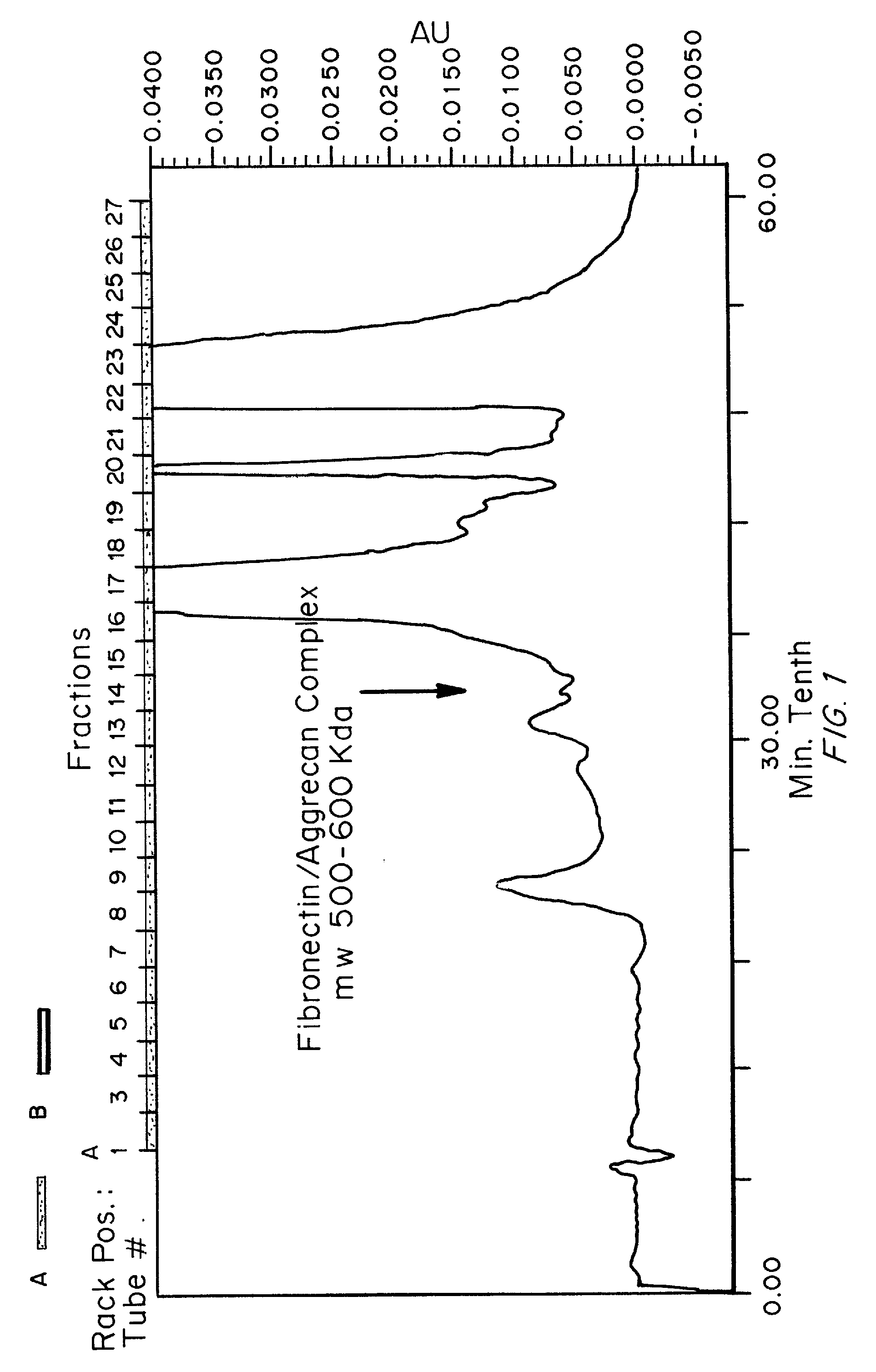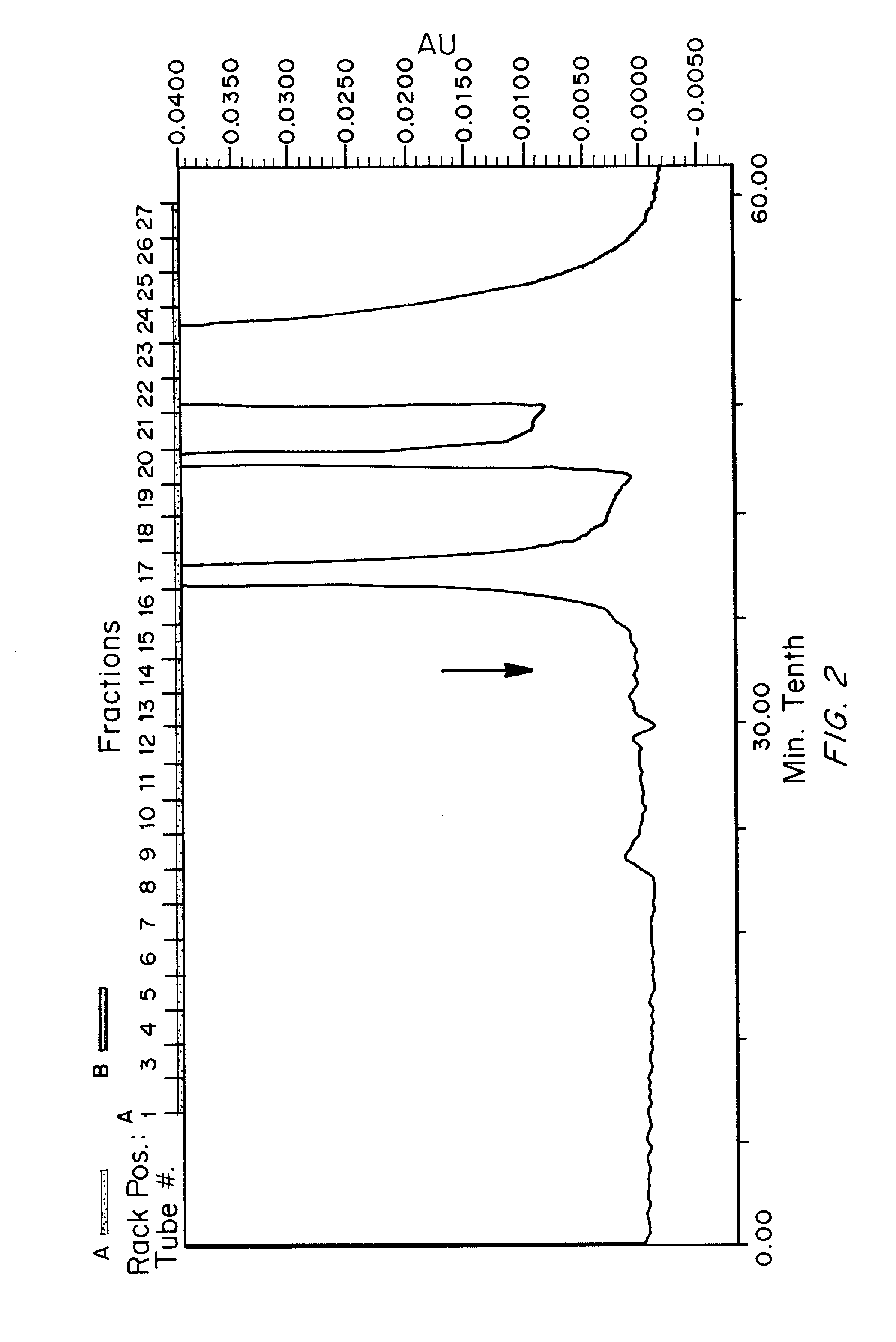Biomarkers and methods for detecting and treating spinal and joint pain
a biomarker and spinal joint technology, applied in the direction of dna/rna fragmentation, peptide/protein ingredients, depsipeptides, etc., can solve the problems of difficult identification difficult treatment of spinal and joint pain, joint injury, etc., to reduce the expression of fibronectin, inhibit or reduce one or more biological activities, and reduce the formation
- Summary
- Abstract
- Description
- Claims
- Application Information
AI Technical Summary
Benefits of technology
Problems solved by technology
Method used
Image
Examples
example 1
Application of Chromatography for the Purification of Fibronectin-Aggrecan Complexes from Human Samples
[0235]To purify fibronectin-aggrecan complexes from a disc lavage sample or synovial fluid, size exclusion chromatography (SEC) followed by anion-exchange chromatography was performed. SEC and anion-exchange chromatography were carried out using the Bio-Rad BioLogic DuoFlow® computer controlled HPLC system equipped with BioLogic QuadTec® UV / VIS detector and conductivity monitor.
[0236]SEC was performed using two Bio-Rad® SEC-400-5 columns in series using isocratic elution with 50 mM Tris / HCl, 100 mM NaCl, pH 8.0. The resulting fractions were analyzed for total protein content (A280nm and A215nm) and for the presence of the discovered biomarker consisting of Fibronectin complexes with aggrecan fragment. FIG. 1 shows the SEC-HPLC elution profile (A215nm) for a symptomatic sample and FIG. 2 shows the SEC-HPLC elution profile for an asymptomatic sample under the same conditions. Subsequ...
example 2
Silver Stain and Western Blot Analysis Using Anti-Fibronectin, and Anti-Aggrecan (G3 Domain) Specific Antibodies
[0239]Example 1 demonstrates the fractionation of a human sample by SEC-HPLC. Fractions 14 and 15 from the SEC analysis were subjected to SDS-PAGE separation followed by silver staining or Western blotting to determine the size of the proteins in the fractions and to probe their identity. Western blotting was conducted using standard methods using anti-fibronectin monoclonal (DiaPharma Group, Inc. detection antibody from DPGR028A fibronectin ELISA kit), and anti-aggrecan monoclonal (G3 domain) (Santa Cruz Biotechnology, Aggrecan C20, sc-16493) specific antibodies.
[0240]Silver staining analysis showed the presence of proteins in the range of greater than 250 Kd in both fractions. Western blotting using the anti-fibronectin monoclonal and anti-aggrecan monoclonal (G3 domain) antibodies revealed immunoreactive band at a molecular weight range of 400-600 Kd, indicating that th...
example 3
Analysis of Aggrecan Domains that Co-Migrate with Fibronectin Through Polyacrylamide Gels
[0241]Size exclusion chromatography of a single human sample was conducted as described in Example 1 and eluted fractions 8 through 20 from the SEC were subjected to separation by SDS-PAGE and then transferred to membranes for Western blotting using polyclonal anti-aggrecan G1 (Santa Cruz Biotechnology, Aggrecan D20, se-16492), G2 (Santa Cruz Biotechnology, Aggrecan E12, se-67513) or G3 (Santa Cruz Biotechnology, Aggrecan C20, sc-16493) antibodies. Western blots using the anti-aggrecan G3 domain antibody revealed immunoreactive bands of different molecular sizes in fractions 8-20, corresponding to various proteolytic fragments of aggrecan containing the G3 domain. Western blots using the anti-aggrecan G1 domain antibody revealed immunoreactive bands in fractions 8-20 that exhibited a different banding pattern than that observed using the anti-aggrecan G3 domain antibody.
[0242]Western blots using...
PUM
| Property | Measurement | Unit |
|---|---|---|
| dissociation constant | aaaaa | aaaaa |
| volume | aaaaa | aaaaa |
| pH | aaaaa | aaaaa |
Abstract
Description
Claims
Application Information
 Login to View More
Login to View More - R&D
- Intellectual Property
- Life Sciences
- Materials
- Tech Scout
- Unparalleled Data Quality
- Higher Quality Content
- 60% Fewer Hallucinations
Browse by: Latest US Patents, China's latest patents, Technical Efficacy Thesaurus, Application Domain, Technology Topic, Popular Technical Reports.
© 2025 PatSnap. All rights reserved.Legal|Privacy policy|Modern Slavery Act Transparency Statement|Sitemap|About US| Contact US: help@patsnap.com



